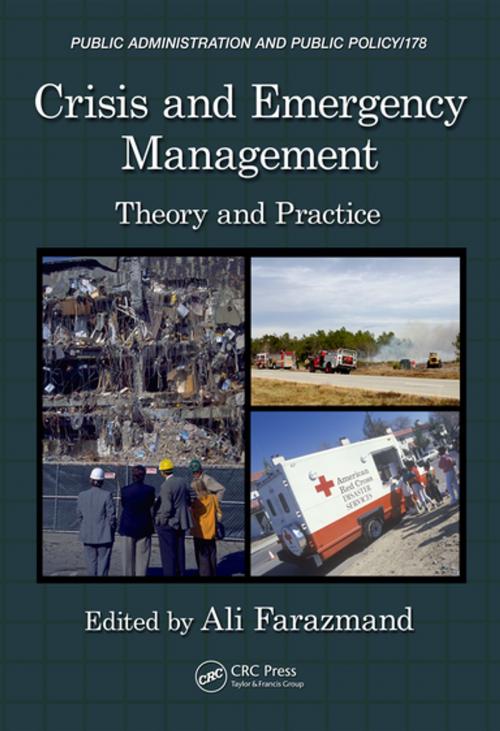Crisis and Emergency Management
Theory and Practice, Second Edition
Nonfiction, Social & Cultural Studies, Political Science| Author: | Ali Farazmand | ISBN: | 9781351570572 |
| Publisher: | Taylor and Francis | Publication: | September 25, 2017 |
| Imprint: | Routledge | Language: | English |
| Author: | Ali Farazmand |
| ISBN: | 9781351570572 |
| Publisher: | Taylor and Francis |
| Publication: | September 25, 2017 |
| Imprint: | Routledge |
| Language: | English |
More than 12 years have passed since the publication of the first edition of Crisis and Emergency Management. During that time numerous disasters—from 9/11 to massive earthquakes in Iran and China, to the giant Asian Tsunami, Hurricane Katrina, and the Fukushima Tsunami and ensuing nuclear meltdown—have changed the way we manage catastrophic events. With contributions from leading experts, this second edition features 40 new chapters that address recent worldwide crises and what we have learned from emergency responses to them.
See What’s New in the Second Edition:
- Up-to-date concepts, theories, and practices
- Analysis of recent disasters and their effect on emergency management
- Policy and managerial lessons
- Suggestions for capacity building in crisis and emergency management
The book covers a wide range of international issues using critical, empirical, and quantitative analyses. It discusses various approaches to topics such as resolving political tension and terrorism issues, the potential use of biological weapons, and the role of public relations in crisis. The author offers insight into organizational and community resiliency development; a "surprise management" theory in practice for upgrading the knowledge and skills in managing crises and governing emergencies; and better and more effective organizational, political, social, and managerial coordination in the processes. He presents case studies that enhance and advance the future theory and practice of crisis and emergency management, while at the same time providing practical advice that can be put to use immediately.
Managing crises and governing emergencies in such an age of challenges demands a different kind of knowledge, skills, and attitudes that were not available yesterday. This book gives you valuable information with applications at the macro, micro, organizational, and interorganizational levels, preparing you for emergency management in an increasingly globalized and uncertain world.
More than 12 years have passed since the publication of the first edition of Crisis and Emergency Management. During that time numerous disasters—from 9/11 to massive earthquakes in Iran and China, to the giant Asian Tsunami, Hurricane Katrina, and the Fukushima Tsunami and ensuing nuclear meltdown—have changed the way we manage catastrophic events. With contributions from leading experts, this second edition features 40 new chapters that address recent worldwide crises and what we have learned from emergency responses to them.
See What’s New in the Second Edition:
- Up-to-date concepts, theories, and practices
- Analysis of recent disasters and their effect on emergency management
- Policy and managerial lessons
- Suggestions for capacity building in crisis and emergency management
The book covers a wide range of international issues using critical, empirical, and quantitative analyses. It discusses various approaches to topics such as resolving political tension and terrorism issues, the potential use of biological weapons, and the role of public relations in crisis. The author offers insight into organizational and community resiliency development; a "surprise management" theory in practice for upgrading the knowledge and skills in managing crises and governing emergencies; and better and more effective organizational, political, social, and managerial coordination in the processes. He presents case studies that enhance and advance the future theory and practice of crisis and emergency management, while at the same time providing practical advice that can be put to use immediately.
Managing crises and governing emergencies in such an age of challenges demands a different kind of knowledge, skills, and attitudes that were not available yesterday. This book gives you valuable information with applications at the macro, micro, organizational, and interorganizational levels, preparing you for emergency management in an increasingly globalized and uncertain world.















